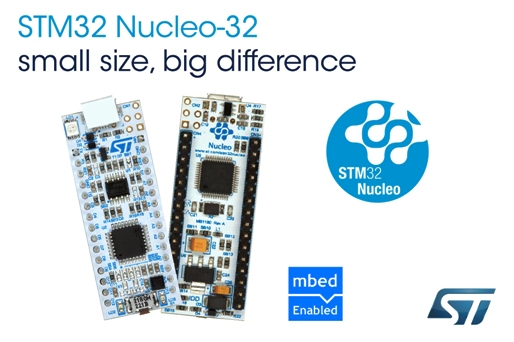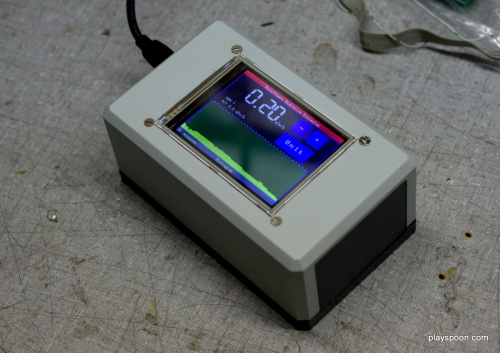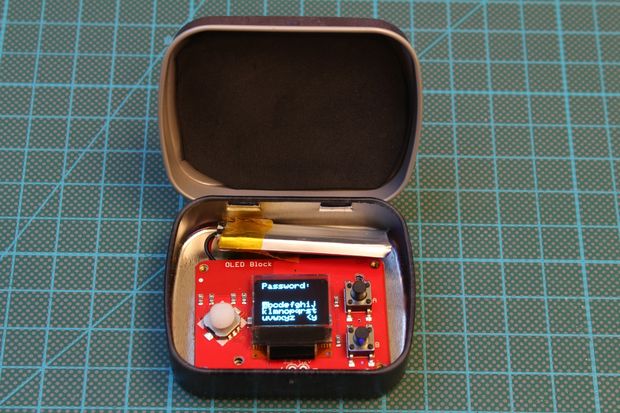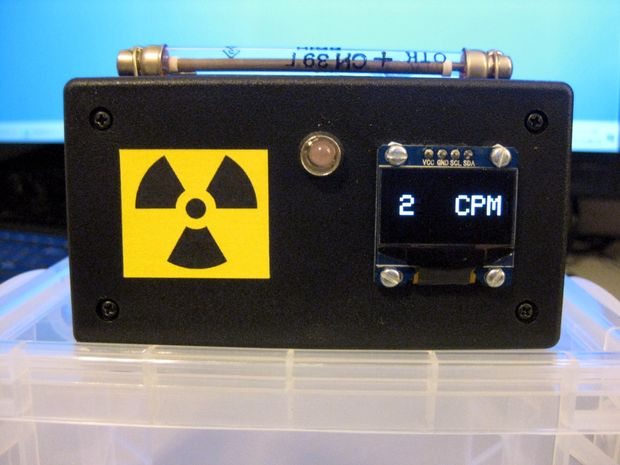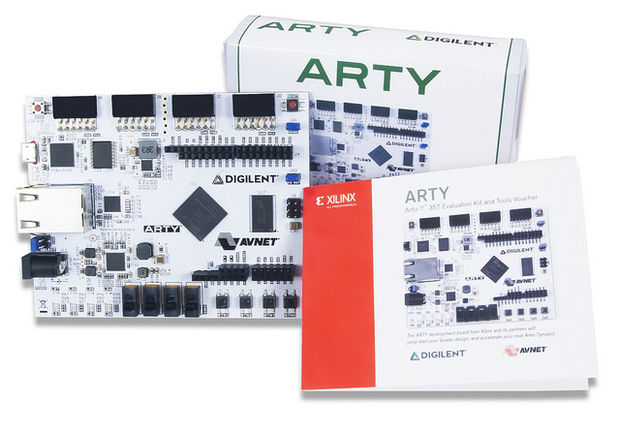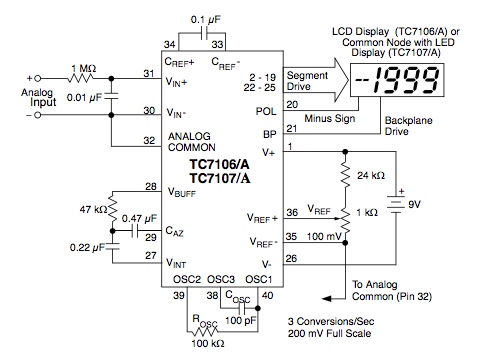Rigol DSA875-TG 9kHz – 7.5GHz Spectrum Analyzer & Tracking Generator Review, Teardown & Experiments – [Link]
STM extend Nucleo range
by Martin Cooke @ elektormagazine.com
STMicroelectronics has extended its range of STM32 Nucleo development boards with scalable, small-form-factor variants to support the 32-pin members of its STM32 microcontroller family. The STM32 Nucleo-32 boards come with support from a choice of IDEs and access to mbed online resources. The STM32 Nucleo open platform is said to enable affordable prototyping using STM32 MCUs combined with a range of hardware plug-ins using Arduino Nano connectors.
Developers can also take full advantage of the STM32 software libraries as well as STM32Cube tools to facilitate software development and port designs from one STM32 variant to another. The STM32 Nucleo boards include the ST-LINK debugger/programmer, which enables drag-and-drop flash programming, so there is no need for a separate debug probe. Since the STM32 Nucleo boards are mbed-enabled, developers can make use of the mbed online tools and collaboration infrastructure at the mbed website.
STM extend Nucleo range – [Link]
Cranial Electrotherapy Stimulator
This cranial electrotherapy stimulator is a medical treatment that makes use of electrical energy to treat anxiety, depression and insomnia. It is a therapeutic tool to help heal the body, which primarily uses an electrical current to stimulate nerves and muscles through the skin. This device uses a few components such as 555 timer, decade counter and the TE connectivity’s slide switch and trimmer. This TE connectivity components offer high-performance designed to withstand extreme shock, vibration, temperature and altitude.
The circuit generates an adjustable current that flows through the clips that are placed on the earlobes. The waveform of this device is 400 milliseconds positive pulse followed by a negative one of the same duration, then a pause of 1.2 seconds. The main frequency is 0.5 Hz and doubles the pulse every 2 seconds. This specialized electrical impulse achieves a state of relaxation.
Electrotherapy stimulator is a simple device that can be easily constructed by electronics enthusiasts. It only needs a few components that are readily available in the market. This device can be applied to variety of treatments that include chronic pain and other medical conditions such as headaches and gout. See also some designs running on 9V.
Cranial Electrotherapy Stimulator – [Link]
DIY Oscilloscope using Arduino and Graphic LCD
Prasad Pandit @ youtube.com:
I have designed an Oscilloscope using Arduino Mega 2560 and 128×64 GLCD. It works pretty good for verification of signal the range of input frequency is upto 10-12MHz and Sampling rate is 200KSPS. It has no Attenuation so you will have to convert highvoltage signal to 5 v pTp signal. And yes for Sine wave or Cos wave or signal which is below ground voltage you will have to DC shift the signal. You can set the Time/Division for studying signal. It gives Peak to Peak voltage value of signal in Real Time till two decimals.
All the Arduino GLCD libraries used are freely available. If you have suggestions mail me on: prasadp4009@gmail.com
Code Link: www.dropbox.com
DIY Oscilloscope using Arduino and Graphic LCD – [Link]
Touchscreen-controlled Arduino Geiger Counter
by Toumal @ github.com:
A touchscreen-controlled Geiger Counter for Arduino. Requires a Radiation Watch Pocket Geiger sensor, a ITDB02 Display from SainSmart and an Arduino Mega.
Software needs my fork of the RadiationWatch library, the ITDB02 library as well as the UTouch library
Touchscreen-controlled Arduino Geiger Counter – [Link]
An Edison-Based Password Keeper
by DanielGilbert @ instructables.com:
With this instructable, I try to solve a problem everyone has: Passwords. Accounts. Logins. All the stuff you need to get into your favourite social media site, shopping site, blog or forum (they still exist, huh?). Now, there are several ways to control your accounts:
Use always the same credentials: No. Never ever do that. Seriously. If your account gets hacked on one site, chance is that the hacker(s) will try the credentials on other, popular sites also. Don’t underestimate them. They are smart. Criminals, but smart.
Use a software on every device: You can do that. And if you are lucky, this software will run forever on this device. But maybe, at some point, you will get rid of the devices. Uh-oh…
Write them down: Yepp. You can do that. But – everyone who finds your book will be able to read your passwords. That wouldn’t be that great, right?To solve all of this, I created a device called “The PinTin Nano”. It has it’s name from the fact that it’s a) pretty small and b) fits in a mint tin. I love that, because that makes the device easy to carry around.
An Edison-Based Password Keeper – [Link]
Arduino Mini Geiger Counter
by paulindallas @ instructables.com:
Last Black Friday, the big sale day that comes right after Thanksgiving, I came across a sale on the Electronic Goldmine web site for a Geiger counter kit and tube for about $30. Now I always wanted to play with a Geiger counter, even as a kid back in the 50’s when Uranium, nuclear power, mutant radioactive ants (the movie “THEM” 1954) etc. were all the rage. I figured I was not getting any younger, so I bought it.
Arduino Mini Geiger Counter – [Link]
Getting Started with Arty
by kaitlyn1franz @ instructables.com:
Digilent recently released a new FPGA development board. The Arty board. The Arty is designed to be used exclusively with Xilinx Vivado, and designed specifically for use with microblaze.
This tutorial covers how to use the out of he box design that ships loaded into Arty’s Quad-SPI Flash, with I/O and UART.
To view the reference material and other demo projects for Arty, go to the Arty resource center.
Getting Started with Arty – [Link]
TC7106 – 3 1/2 Digit ADC for LCD Display
The TC7106 3½ digit LCD direct-display drive analog-to-digital converter has a reference with a 80ppm/°C max temperature coefficient. TC7106 based systems may be upgraded without changing external passive component values to the TC7106A for a more precise system. High impedance differential inputs offer 1pA leakage current and a 1012 Ohm input impedance. The differential reference input allows ratiometric measurements for ohms or bridge transducer measurements. The 15µVp-p noise performance guarantees a great reading. The auto-zero cycle guarantees a zero display reading with a zero-volts input.
TC7106 – 3 1/2 Digit ADC for LCD Display – [Link]
Record from SOS webinar – Everything you have ever wanted to know about Physics of Humidity
Accuracy in a whole range of relative humidity measurement? You could find out during Sensirion webinar. Did you miss our webinar? Watch the video – record…
What´s possible and what not in the temperature and humidity measurement? Design Guidance & Handling Instructions for your applications and products and also application examples. All of this was led by Maximilian Eichbereger from Sensirion.All participants of the webinar could get development kit EK-H5 for special price and as a bonus could get the SHT31 reference design (functional board) for FREE.
Record from SOS webinar – Everything you have ever wanted to know about Physics of Humidity – [Link]




